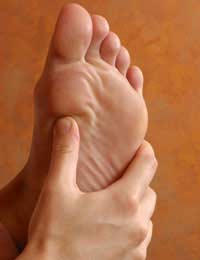What is Reflexology?

Reflexology is the holistic practice of applying pressure to certain points of the feet, hands, and even sometimes the ears in order to have a beneficial health effect on a certain part of the body. These points correspond with a system of zones, so therefore reflexology is sometimes known as zone therapy. There are reflexology maps of the feet, hands, and ears, which tell you what part of the anatomy will receive a corresponding therapeutic effect when that point is massaged. For example, massaging the bottom centre of the big toe is supposed to stimulate the pituitary gland. The pituitary gland is often known as "The Master Gland" because it can affect metabolism, blood pressure, sexuality, reproduction, and other vital functions.
It is believed that reflexology works by unblocking an imbalance in the body that often follows illness, stress, injury, or disease. Using reflexology to return the balance to the body can help restore and maintain the body's natural equilibrium and promote healing.
History of Reflexology
Reflexology has been practiced for thousands of years. Archeologists have found evidence that it was used by the Egyptians as far back as 2330 BCE, the Chinese as far back as 2704 BCE, and the Japanese as far back as 690 CD. Reflexology did not become embraced by Western world until the early 19th century. Drs. William H. Fitzgerald and Edwin Bowers introduced it to the United States in 1913. Eunice D. Ingham was a nurse and physiotherapist that helped further develop the practice during the 30's and 40's. She mapped the body into reflexes and the practice was renamed from zone therapy to reflexology at this time.
How Reflexology Works
The body is divided into different zones and each zone is represented by a point on the foot or hand. The left foot and hand represent the left side of the body, whereas the right foot and hand represent the right side of the body. The inside of the foot and hand reflect the spine while the outside reflects the arm and shoulder. The toes and fingers contain points for the head, neck, and some internal parts of the body. The ball of the foot is representative of the chest and upper back, including the heart and lungs.
It is believe that by rubbing certain parts of the foot or hand, you stimulate the nerve endings, which unblock the natural energy field, and helps heal the corresponding part of the body.
Going in for Treatment
The first time you visit a reflexologist, you should expect to answer some questions about your general overall health. It is also acceptable for you to ask him or her questions, such as how long he or she has been in practice and if he or she belongs to any professional reflexology associations.
When the session begins, the practitioner will then perform an examination your feet and hands, during which you remain fully clothed. He or she will begin to massage your feet and hands and make note of any problem areas revealed. This massage should never be painful, but if it is, you should mention it to the practitioner.
The first session should last between 30 minutes and an hour. The amount of additional treatments needed depends on the needs of your body, but your reflexologist should discuss the full course of treatment with you after the first session. Most people feel one of two ways after the first session - either relaxed or lethargic. You should let you practitioner know how you feel at the end of the first session as it can help him or her know how your body is responding to the treatment. If you cannot visit a reflexologist or there is none in your area, you can learn the art yourself through books or by taking an online course.
Certain studies show that reflexology can not only help with relaxation, but also premenstrual syndrome, headaches, irritable bowl syndrome, constipation, multiple sclerosis, and in relieving cancer pain.
- Gardening - A Stress Reliever?
- Using Prayer when Coping with Stress
- Using Hypnosis to Overcome Stress
- What to Look for in a Massage Chair
- Acupuncture
- Choosing a Masseuse
- Decluttering and Organising
- Mini De-Stress Techniques
- How to Avoid Stress in Your Environment
- Time Management and Stress
- How to Help Children Avoid Stress
- How to Avoid Stress at Home
- How to Avoid Stress at Work


Re: Signs of Stress in Children
Hello, I work with children who worry. Some times there are specific reasons for the child to be worried and communicating with…
Re: Signs of Stress in Children
Hello.... My daughter age 12 was crying yesterday about not wanting to go on guides trip to France.... She had a bad experience on…
Re: Mini De-Stress Techniques
Proper breathing technique or yoga stretches can be the perfect stress reliever at work and only take five minutes. Grab the time from…
Re: Mini De-Stress Techniques
There are people who swear by foot massagers and foot baths to take away the stress, especially when they've spent all day on their…